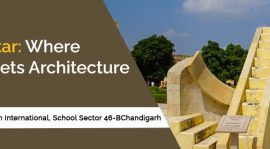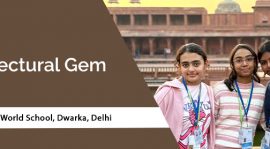Posted on Dec 12, 2023 in India Discovery,Student Speak
1 Comment

With its enchanting natural beauty and diverse wildlife, Ranthambore is a year-round favourite destination among tourists. In the course of our visit, we uncovered an interesting fact about the origin of the name “Ranthambore,” which is derived from the two prominent hills in the area, namely Ran and Thambore. Nestled amidst the hills of the Aravali and the Vindhyas, the region’s geographical setting accounts for the refreshing cold weather we experienced during our exploration.

Home to a large number of Royal Bengal tigers, Indian porcupines, leopards, monkeys and various other species the national park in Ranthambore stands as the last expanse of dry-deciduous Anogeissus Pendula Forest.

The Royal Bengal Tigers found in Ranthambore National Park are endangered and rarely sighted. The perilous state of these tigers traces back to historical rampant hunting. In the past, they were hunted for various body parts believed to possess medicinal benefits. Tiger whiskers were considered a cure for toothaches, while their tails were believed to have healing properties for skin diseases.

During our journey, we embarked on two jungle safaris. Some of our friends were lucky enough to spot leopards and tigers. Meanwhile, the rest of us encountered wild boars. We discovered that leopards are skilled swimmers and climbers and can adapt well to human-dominated landscapes. In contrast, wild boars are aggressive and dangerous animals. Additionally, our safari allowed us to witness troops of Rhesus monkeys, lively and agile, and Indian porcupines adorned with sharp quills.

We had a session with Mr Pankaj Joshi, a naturalist with a remarkable forty-year career as a forest ranger and wildlife photographer. He told us about Machli, the tiger queen, who killed a 14-foot-long crocodile. She defended her territory and cubs valiantly even after losing her canine teeth and one of her eyes.

We also went to the Ranthambore Fort, where we delved into its fascinating history. The fort is said to have been built by the Chauhan king Hammir Dev in the 8th century. It was considered invincible because of its cleverly planned layout and strategic location. One notable event in its history occurred in 1301 when the fort faced a formidable challenge. Allauddin Khilji, the Sultan of Delhi, launched an attack on this formidable stronghold. The fort’s resilience and the strategic prowess that once made it seemingly impregnable were put to the test during this significant historical event.

Our mode of transportation throughout Ranthambore was canters, providing a more immersive experience compared to buses. The canters allowed us to fully appreciate the scenic landscape and the rich biodiversity of this destination.

Overall, our journey in Ranthambore was not only fun but also educational, teaching us about the importance of wildlife and nature conservation. The Edterra Edventures’ Journey Mentors ensured that we wouldn’t return home with vague memories, like “Kaha gaye the?” (Where did you go?) and “Kya dekha?” (What did you see?) – Pedh (tree).
Writen By Anovshka, Dhruvi, Mehal, Nitya, Tara, Tvisha, Vania & Vertika (Shiv Nadar School Sector 26A, Gurugram).
__
EdTerra Edventures conducts various other programs for the youth. If you go to school and are under 17 years of age, ask your school to contact us to arrange a visit to your school for an introduction to “Ranthambore: Tiger’s Own Den” and other journeys under EdTerra’s India Discovery Program.
For queries call +91-11-48885800 or visit EdTerra Browse Journeys page to know more about the programs for school students. Visit our FB page by clicking HERE. Also, check our podcast page by clicking HERE.

During our trip to...

Our trip to Udaipur...

We recently visited the...

On our journey to...

Yo yo yo, yo...

Nestled in the foothills...

Our Ganga International School...

In the heart of...

There are places you...

Our first journey to...
See What Our Edventurers Experience!